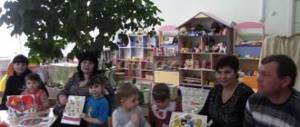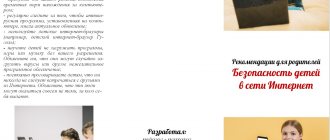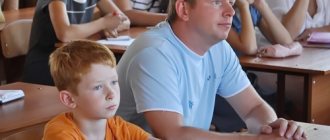MAGAZINE Preschooler.RF
Parent meeting in kindergarten in a non-traditional formA parent meeting is a way of interaction between a teacher and parents on any topical issue, but today the meaning of such meetings comes down only to solving organizational issues. Parents don't like to go to such events. Why? Because they are boring, drawn-out, static and ultimately ineffective.
The task of any educator as a teacher is to seriously prepare for such meetings. For interaction to be effective, it is not enough to develop the course of the meeting and outline the key points - it is necessary to structure the meeting in such a way that the teacher, instead of a lecturer, a subject of interaction, becomes a partner of the parents.
In my educational work, I adhere to the following principle: any parent meeting should be unusual, unconventional, it should be held as a holiday, as a game. In this case, parents have a greater desire to be present, because adults, as you know, are big children, and they, like kids, simply need positive emotions.
In order to make it easier to work with students, we are forming a children's team. It is also necessary to form a team of parents, because it is easier and more effective to work with a group.
How difficult it can be to organize a cleanup day or a group trip! Only a few come to help, and not because all the parents are too busy, but simply because there is no desire. Therefore, it is necessary to form a parental activist group - let it be a parent committee at first. Remember how in the film “Moscow Doesn’t Believe in Tears” : “It’s difficult with three, but when you learn to organize three, then the number no longer matters .
By building active and friendly relationships between all the parents of the group, you will strengthen the educational process, find support for your pedagogical endeavors and creativity, which will ultimately have a positive impact on the development of children.
The first orientation parent meeting is very important, when you set the tone for all your future work, you present not only the group, but also yourself.
So how do you conduct that first parent-teacher meeting?
Step 1 - organize the environment correctly
Traditionally, parents are seated at tables while the teacher stands. Now imagine how uncomfortable parents feel: on a small chair at a small table... All our lives we have been accustomed to sitting this way: in kindergarten, school, college. Psychologically, we perceive such a posture and placement in space as follows: now I will only listen, they will teach me, and no one will particularly listen to my opinion, because I am in the place of a student or pupil, and not in the place of an educator or teacher. Because of this placement, it is most often impossible to establish proper contact with parents.
One of the ways to create a good microclimate is to sit the parents in a circle: in this way everyone is on an equal footing, and a dialogue can arise between the teacher and the parent.
Step 2 - introduction
Polite people always say hello when they meet. For some reason, in our education system it is customary to introduce yourself only to the teacher. The words “My name is so-and-so” from the parents’ point of view are deciphered something like this: “What is your name, it’s not really important to me, I still won’t remember everyone right away - there are many of you, and I’m alone .
Let me remind you: our goal is to form a parent team. Therefore, we must give everyone the opportunity to introduce themselves. To do this, you can use a toy that the participants pass around in a circle, saying their name.
Also at this stage, express diagnostics are carried out to understand what kind of character the people are sitting in front of you. To do this, you can use the “Geometric Figures” (Yu. A. Zakharov).
Step 3 - establishing a favorable working microclimate
Parents come to a new group wary. This is understandable: you have to give your precious child to a stranger, a stranger, for the whole day. Will they hurt the baby? Will they take care of him? Such fears are often supported by scary stories from television programs or the Internet about tyrant teachers.
Relieving parents of such anxiety is very important. This can be facilitated by the exercise “Repeat your name” ( “Swap places those who…”, etc.). The exercise can be done sitting or standing. Each participant in a circle calls his name and shows some kind of movement with the words: “I do this...” Each subsequent participant first repeats all the names and movements of the previous ones, and then says his name and shows his movement. Thus, the last participant must repeat the names and movements of all other group members.
Step 4 - group work
We continue to get to know the parents. Relaxed after games and exercises, having learned a little about the characters of those present, parents are already ready for communication and dialogue. Now we can find out what they generally expect from kindergarten? To do this, you can use the “Your Expectations” . Parents write one word on the board, characterizing their expectations from the kindergarten, teachers, and administration. Then it is proposed to collectively rank these expectations in descending order. Thus, the teacher understands the position of the parents, and the parents form ideas about what kindergarten is needed for, what is real and what is not.
Step 5 - Give Parents an Opportunity to Ask Questions
Many parents, for whatever reason, are embarrassed to ask questions that interest them, and then worry that they have not received complete information about the educational process and everyday issues. Therefore, you can use the “Basket of Questions” (on a piece of paper, anonymously write the most important question, from the parent’s point of view). In this case, the situation of understatement and uncertainty disappears.
Step 6 - end of the parent meeting, summing up - reflection,
It is very important to sum it up correctly and let moms and dads speak about the feelings and emotions they experienced at the first parent-teacher meeting. To do this, you can use the exercise “Tying Thread” . Participants stand in a circle. The teacher passes the ball around and invites the participants to speak: describe their mood, talk about their feelings - what they liked, what they didn’t and why.
It’s good if there is a collective handshake at the end of the meeting - this will reinforce a positive and good-natured attitude.
After a parent meeting held in this form, parents, as a rule, leave in a good mood, without feelings of dissatisfaction or fatigue.
The “first brick” in building the parent team has been laid. The more such “building blocks” , the more interesting and exciting your work in educating the younger generation will become.
Remember: adults are big children, and you need to play with them too!
| Next > |
Modern forms of working with parents in preschool institutions
"Open Days".
Currently they are becoming widespread.
However, today we can talk about this form of communication between teachers and parents as non-traditional, due to changes in the principles of interaction between teachers and parents. According to researchers, a preschool institution is able to fully satisfy the needs of parents only if it is an open system. “Open Days” give parents the opportunity to see the style of communication between teachers and children, and to “get involved” in the communication and activities of children and teachers. If previously it was not assumed that a parent could be an active participant in the life of children when visiting a group, now preschool institutions strive not only to demonstrate the pedagogical process to parents, but also to involve them in it. On this day, parents, as well as other people close to the child who are directly involved in his upbringing (grandparents, brothers and sisters), have the opportunity to freely visit the preschool; walk through all its premises, get acquainted with the life of a child in kindergarten, see how the child studies and relaxes, communicate with his friends and teachers. Parents, observing the activities of the teacher and children, can themselves participate in games, activities, etc. (Appendix 8. Open Day Scenario).
Presentation of a preschool institution
. This is a form of advertising for preschool educational institutions, modernized in accordance with the newly opened computer capabilities. As a result of this form of work, parents get acquainted with the charter of the preschool educational institution, the development program and the team of teachers, and receive useful information about the content of work with children, paid and free services.
Clubs for parents.
This form of communication presupposes the establishment of a trusting relationship between teachers and parents, awareness by teachers of the importance of family in raising a child, and by parents that teachers have the opportunity to help them in solving emerging difficulties in upbringing.
Meetings of clubs for parents are held regularly. The choice of topic for discussion is determined by the interests and requests of the parents. Teachers strive not only to prepare useful and interesting information themselves on a problem that worries parents, but also invite various specialists (Appendix 9. Caring Parents Club)
Oral pedagogical journal
.
The magazine consists of 3-6 pages, each lasting from 5 to 10 minutes. The total duration is no more than 40 minutes (Appendix 10. Oral journal script).
The short duration of time is of no small importance, since parents are often limited in time due to various objective and subjective reasons. Therefore, it is important that a sufficiently large amount of information placed in a relatively short period of time is of significant interest to parents. Each page of the magazine is an oral message that can be illustrated with teaching aids, listening to tape recordings, exhibitions of drawings, crafts, and books. Parents are offered literature in advance to familiarize themselves with the problem, practical assignments, and questions for discussion. Sample topics of Oral Journals proposed by teachers: “At the threshold of the school”, “Ethics of family relationships”, “The influence of nature on the spiritual development of the child” and others. It is important that the topics are relevant to parents, meet their needs and help solve the most important issues in raising children.
LiveInternetLiveInternet
Quote from Svetlana_Goryacheva's message
Read in full In your quotation book or community!
Non-standard forms of holding parent meetings in kindergarten.
Many Russians now have a computer at home connected to the Internet. And on the Internet you can find everything a child wants: cartoons, computer games of any level, audio stories, coloring books and much, much more. Why should a child also “get into the computer” in kindergarten?
I believe that computerized teacher programs should be aimed at working with parents. Computer Internet communication in kindergarten is, first of all, a quick connection with parents. All parents of children work a lot and hard, and as a rule, there is not enough time. And then the teacher asks to come to the parent meeting. As a rule, one part of the parents comes to the meeting, the other part does not come for good reasons, and the third part ignores the meeting. But only the Internet can bring everyone together!
For example, a teacher makes a presentation on the topic of the meeting in the form of colorful slide shows showing videos or photos of children from the group and sends it to each mother of a child by email. The most ignorant dad will not miss such a presentation! He will also post a photo or video on social networks of his child reciting a poem in kindergarten. Today, in the age of social media boom, everyone wants to constantly update their social media account or profile with new information.
You can make exactly as many such presentations as you need to hold parent meetings per year.
In the pre-school group, parents begin to worry about how their child is mastering the kindergarten program. Drawings, applications and other crafts are always on display. Parents see this. What about oral lessons?
It’s great if the teacher prepares a presentation for each oral lesson! The presentation can be sent to parents by email. Caring parents will definitely fulfill all the requests and recommendations of the teacher.
Parents will show their child the submitted presentation and ask him to remember and tell what happened in the lesson. The teacher cannot, within the framework of one lesson, ask each child, for example, to retell a story. At home, in a familiar environment for the child, looking at the presentation sent by the teacher, and remembering everything that was said in the lesson, he can perfectly retell, for example, a story or some other information. In this case, the presentation slides will play the role of original picture prompts that help the child recall the activity in kindergarten.
The teacher can record the progress of the lesson on a video camera and send it by email to the children’s parents.
You can open a blog on the Internet for parents of a kindergarten or group.
This modern and new form of working with parents, it seems to me, will appeal not only to parents, but also to educators.
Together, educators can create a library of presentations so that every educator can find everything they need to conduct a modern lesson.
Perhaps you can come up with something else interesting!
I would like to wish all teachers successful mastery of the computer and various computer programs!
Series of messages “To the teacher’s piggy bank.”:
Part 1 - How to choose the right rubber boots for a child Part 2 - Plot-role-playing game. Part 3 - Kindergarten in Israel. Part 4 - Non-standard forms of holding parent meetings in kindergarten. Part 5 - Festive cognitive and speech lesson dedicated to Defender of the Fatherland Day, for m Part 6 - The Russian stove is the breadwinner for the whole house. ... Part 39 - “COINCIDENCES” Attention exercise. Part 40 - Game “Dominoes - traces” Part 41 - Bear in fairy tales.


